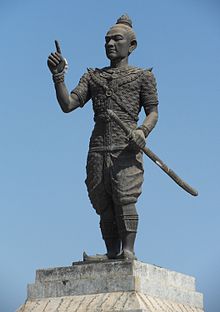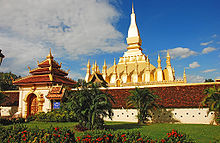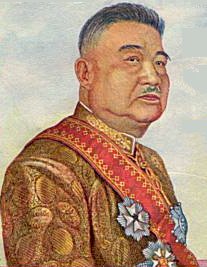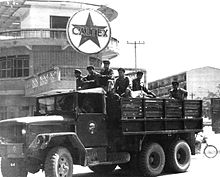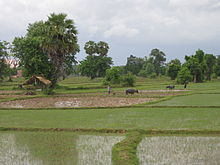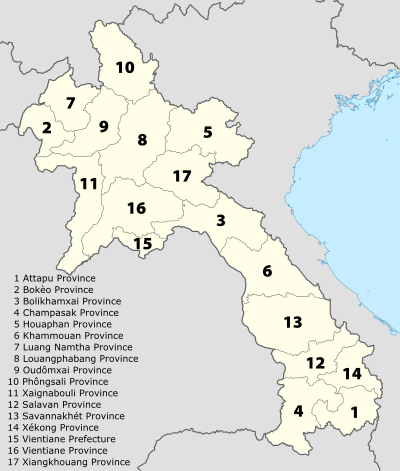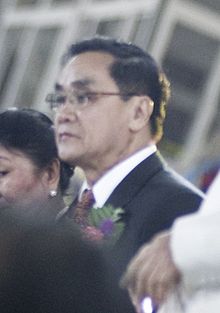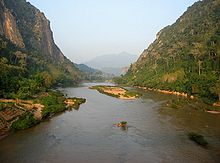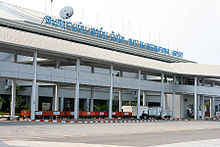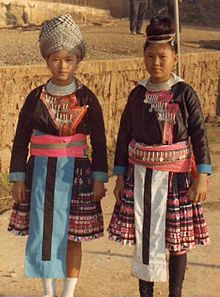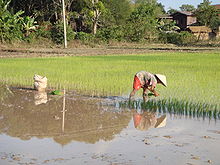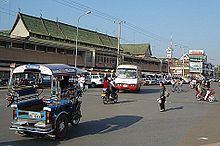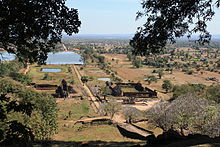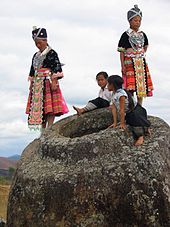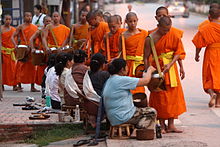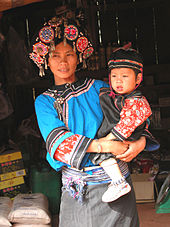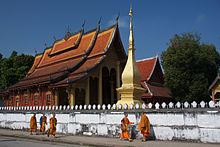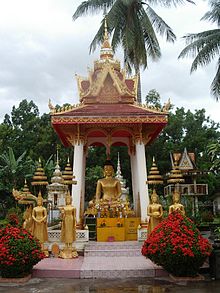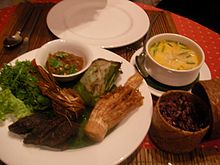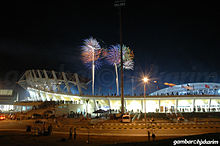
Laos
About this schools Wikipedia selection
SOS believes education gives a better chance in life to children in the developing world too. With SOS Children you can choose to sponsor children in over a hundred countries
Lao People's Democratic Republic
|
||||||
|---|---|---|---|---|---|---|
|
||||||
| Motto: ສັນຕິພາບ ເອກະລາດ ປະຊາທິປະໄຕ ເອກະພາບ ວັດທະນາຖາວອນ "Peace, independence, democracy, unity and prosperity" |
||||||
| Anthem: Pheng Xat Lao Lao National Anthem |
||||||
|
Location of Laos (green)
in ASEAN (dark grey) — [Legend] |
||||||
| Capital and largest city |
Vientiane 17°58′N 102°36′E |
|||||
| Official languages | Lao | |||||
| Official scripts | Lao script | |||||
| Ethnic groups (2005) |
|
|||||
| Demonym | Laotian Lao |
|||||
| Government | Marxist–Leninist single-party state | |||||
| - | President | Choummaly Sayasone | ||||
| - | Prime Minister | Thongsing Thammavong | ||||
| - | General Secretary (Party) |
Choummaly Sayasone | ||||
| - | President of the National Assembly |
Pany Yathotu | ||||
| - | President of Construction |
Sisavath Keobounphanh | ||||
| Legislature | National Assembly | |||||
| Independence from France | ||||||
| - | Autonomy | 19 July 1949 | ||||
| - | Declared | 22 October 1953 | ||||
| Area | ||||||
| - | Total | 236,800 km2 ( 84th) 91,428.991 sq mi |
||||
| - | Water (%) | 2 | ||||
| Population | ||||||
| - | 2012 estimate | 6,500,000 ( 104th) | ||||
| - | 1995 census | 4,574,848 | ||||
| - | Density | 26.7/km2 ( 177th) 69.2/sq mi |
||||
| GDP ( PPP) | 2012 estimate | |||||
| - | Total | $19.158 billion | ||||
| - | Per capita | $3,004 | ||||
| GDP (nominal) | 2012 estimate | |||||
| - | Total | $9.269 billion | ||||
| - | Per capita | $1,320 | ||||
| Gini (2008) | 36.7 medium |
|||||
| HDI (2013) | medium · 138th |
|||||
| Currency | Kip ( LAK) |
|||||
| Time zone | ( UTC+7) | |||||
| Drives on the | right | |||||
| Calling code | +856 | |||||
| ISO 3166 code | LA | |||||
| Internet TLD | .la | |||||
| a. | Including over 100 smaller ethnic groups. | |||||
Laos (( / ˈ l aʊ s /, / ˈ l ɑː . ɒ s /, / ˈ l ɑː . oʊ s /, or / ˈ l eɪ . ɒ s /) Lao Language: ສາທາລະນະລັດ ປະຊາທິປະໄຕ ປະຊາຊົນລາວ, pronounced [sǎː.tʰáː.laʔ.naʔ.lat páʔ.sáː.tʰiʔ.páʔ.tàj páʔ.sáː.són.láːw] Sathalanalat Paxathipatai Paxaxon Lao), officially the Lao People's Democratic Republic, is a landlocked country in Southeast Asia, bordered by Burma and China to the northwest, Vietnam to the east, Cambodia to the south, and Thailand to the west. Its population was estimated to be around 6.5 million in 2012.
Laos traces its history to the kingdom of Lan Xang, which existed from the 14th to the 18th century when it split into three separate kingdoms. In 1893, it became a French protectorate, with the three kingdoms, Luang Phrabang, Vientiane and Champasak, uniting to form what is now known as Laos. It briefly gained independence in 1945 after Japanese occupation, but returned to French rule until it was granted autonomy in 1949. Laos became independent in 1953, with a constitutional monarchy under Sisavang Vong. Shortly after independence, a long civil war ended the monarchy, when the Communist Pathet Lao movement came to power in 1975.
Laos is a single-party socialist republic. The capital city is Vientiane. Other large cities include Luang Prabang, Savannakhet, and Pakse. The official language is Lao. Laos is a multiethnic country with the politically and culturally dominant Lao people making up approximately sixty percent of the population, mostly in the lowlands. Various Mon-Khmer groups, the Hmong, and other indigenous hill tribes, accounting for forty percent of the population, live in the foothills and mountains. Laos' "strategy for development is based on generating electricity from its rivers and selling the power to its neighbours", namely Thailand, China, and Vietnam. Its economy is accelerating rapidly with the demands for its metals. It is a member of the Asia-Pacific Trade Agreement (APTA), Association of Southeast Asian Nations ( ASEAN), East Asia Summit and La Francophonie. Laos applied for membership of the World Trade Organization (WTO) in 1997, and on February 2, 2013 it was granted full membership.
Etymology
In the Lao language, the country's name is "Muang Lao" (ເມືອງລາວ) or "Pathet Lao" (ປະເທດລາວ), both of which literally mean "Lao Country". The French, who united the three separate Lao kingdoms in French Indochina in 1893, named the country as the plural of the dominant and most common ethnic group (in French, the final "s" at the end of a word is usually silent, thus it would be also be pronounced "Lao").
History
Prehistory
In 2009 an ancient skull was recovered from a cave in the Annamite Mountains in northern Laos; the skull is at least 46,000 years old, making it the oldest modern human fossil found to date in Southeast Asia. Archaeological evidence suggests agriculturist society developed during the 4th millennia B.C.. Burial jars and other kinds of sepulchers suggest a complex society in which bronze objects appeared around 1500 B.C., and iron tools were known from 700 B.C. The proto-historic period is characterized by contact with Chinese and Indian civilizations. From the fourth to the eighth century, communities along the Mekong River began to form into townships, or Muang as they were called.
Lan Xang
Laos traces its history to the kingdom of Lan Xang (Million Elephants), founded in the 14th century, by a Lao prince Fa Ngum, who with 10,000 Khmer troops, took over Vientiane . Ngum was descended from a long line of Lao kings, tracing back to Khoun Boulom. He made Theravada Buddhism the state religion and Lan Xang prospered. Within 20 years of its formation, the kingdom expanded eastward to Champa and along the Annamite mountains in Vietnam. His ministers, unable to tolerate his ruthlessness, forced him into exile to the present-day Thai province of Nan in 1373, where he died. Fa Ngum's eldest son, Oun Heuan, came to the throne under the name Samsenthai and reigned for 43 years. During his reign, Lan Xang became an important trade centre. After his death in 1421, Lan Xang collapsed into warring factions for the next 100 years.
In 1520, Photisarath came to the throne and moved the capital from Luang Phrabang to Vientiane to avoid a Burmese invasion. Setthathirat became king in 1548, after his father was killed, and ordered the construction of what would become the symbol of Laos, That Luang. Setthathirat disappeared in the mountains on his way back from a military expedition into Cambodia and Lan Xang began to rapidly decline. It was not until 1637, when Sourigna Vongsa ascended the throne, that Lan Xang would further expand its frontiers. His reign is often regarded as Laos's golden age. When he died, leaving Lan Xang without an heir, the kingdom divided into three principalities. Between 1763 and 1769, Burmese armies overran northern Laos and annexed Luang Phrabang, while Champasak eventually came under Siamese suzerainty.
Chao Anouvong was installed as a vassal king of Vientiane by the Siamese. He encouraged a renaissance of Lao fine arts and literature and improved relations with Luang Phrabang. Although he was pressured to pay tribute to the Vietnamese, he rebelled against the Siamese. The rebellion failed and Vientiane was ransacked. Anouvong was taken to Bangkok as a prisoner, where he died.
French Laos
In the late 19th century, Luang Prabang was ransacked by the Chinese Black Flag Army. France rescued King Oun Kham and added Luang Phrabang to the 'Protectorate' of French Indochina. Shortly after, the Kingdom of Champasak and the territory of Vientiane were also added to the protectorate. King Sisavang Vong of Luang Phrabang became ruler of a unified Laos and Vientiane once again became the capital. Laos never had any importance for France other than as a buffer state between British-influenced Thailand and the more economically important Annam and Tonkin. During their rule, the French introduced the corvee, a system that forced every male Lao to contribute 10 days of manual labor per year to the colonial government. Laos produced tin, rubber, and coffee, but never accounted for more than 1% of French Indochina's exports. By 1940, only 600 French citizens lived in Laos.
Following a brief Japanese occupation during World War II, the country declared its independence on 12 October 1945, but the French under Charles de Gaulle re-asserted control. In 1950 Laos was granted semi-autonomy as an "associated state" within the French Union. France remained in de facto control until 22 October 1953, when Laos gained full independence as a constitutional monarchy.
Independence
In 1955, the U.S. Department of Defense created a special Programs Evaluation Office to replace French support of the Royal Lao Army against the communist Pathet Lao as part of the U.S. containment policy.
In 1960, amidst a series of rebellions, fighting broke out between the Royal Lao Army and the Pathet Lao. A second Provisional Government of National Unity formed by Prince Souvanna Phouma in 1962 proved to be unsuccessful, and the situation steadily deteriorated into large scale civil war between the Royal Laotian government and the Pathet Lao. The Pathet Lao were backed militarily by the NVA and Vietcong.
Laos was also dragged into the Vietnam War since parts of Laos were invaded and occupied by North Vietnam for use as a supply route for its war against the South. In response, the United States initiated a bombing campaign against the North Vietnamese positions, supported regular and irregular anticommunist forces in Laos and supported South Vietnamese incursions into Laos.
In 1968 the North Vietnamese Army launched a multi-division attack to help the Pathet Lao to fight the Royal Lao Army. The attack resulted in the army largely demobilizing, leaving the conflict to irregular forces raised by the United States and Thailand.
Massive aerial bombardment against Pathet Lao and NVA forces was carried out by the United States to prevent the collapse of Lao's central government and to prevent the use of the Ho Chi Minh Trail. It has been reported that Laos was hit by an average of one B‑52 bombload every eight minutes, 24 hours a day, between 1964 and 1973. U.S. bombers dropped more ordnance on Laos in this period than was dropped during the whole of the World War II, with around 700,000 civilian casualties in consequence. Of the 260 million bombs that rained down, particularly on Xiangkhouang Province on the Plain of Jars, some 80 million failed to explode, leaving a deadly legacy. Laos is the most heavily bombed country, per capita, in the world. Because it was particularly heavily affected by cluster bombs during this war, Laos was a strong advocate of the Convention on Cluster Munitions to ban the weapons and assist victims, and hosted the First Meeting of States Parties to the convention in November 2010.
In 1975, the Pathet Lao, along with Vietnam People's Army and backed by the Soviet Union, overthrew the royalist Lao government, forcing King Savang Vatthana to abdicate on 2 December 1975. He later died in captivity.
On 2 December 1975, after taking control of the country, the Pathet Lao government under Kaysone Phomvihane renamed the country as the Lao People's Democratic Republic and signed agreements giving Vietnam the right to station armed forces and to appoint advisers to assist in overseeing the country. Laos was requested in 1979 by the Socialist Republic of Vietnam to end relations with the People's Republic of China, leading to isolation in trade by China, the United States, and other countries.
The conflict between Hmong rebels and the Pathet Lao continued in isolated pockets. The government of Laos has been accused of committing genocide against the Hmong in collaboration with the Vietnamese army, with up to 100,000 killed out of a population of 400,000. From 1975 to 1996, the United States resettled some 250,000 Lao refugees from Thailand, including 130,000 Hmong. (See: Indochina refugee crisis)
Geography
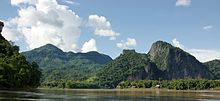
Laos is the only landlocked country in Southeast Asia, and it lies mostly between latitudes 14° and 23°N (a small area is south of 14°), and longitudes 100° and 108°E. Its thickly forested landscape consists mostly of rugged mountains, the highest of which is Phou Bia at 2,818 metres (9,245 ft), with some plains and plateaus. The Mekong River forms a large part of the western boundary with Thailand, whereas the mountains of the Annamite Range form most of the eastern border with Vietnam and the Luang Prabang Range the northwestern border with the Thai highlands. There are two plateaux, the Xiangkhoang in the north and the Bolaven Plateau at the southern end. The climate is tropical and influenced by the monsoon pattern.
There is a distinct rainy season from May to November, followed by a dry season from December to April. Local tradition holds that there are three seasons (rainy, cold and hot) as the latter two months of the climatologically defined dry season are noticeably hotter than the earlier four months. The capital and largest city of Laos is Vientiane and other major cities include Luang Prabang, Savannakhet, and Pakse.
In 1993, the Laos government set aside 21% of the nation's land area for habitat conservation preservation. The country is one of four in the opium poppy growing region known as the " Golden Triangle". According to the October 2007 UNODC fact book "Opium Poppy Cultivation in South East Asia," the poppy cultivation area was 15 square kilometres (5.8 sq mi), down from 18 square kilometres (6.9 sq mi) in 2006.
Laos can be considered to consist of three geographical areas: north, central, and south.
Administrative divisions
Laos is divided into 16 provinces (khoueng) and one prefecture (kampheng nakhon) which includes the capital city Vientiane (Nakhon Louang Viangchan). Provinces are further divided into districts (muang) and then villages (ban). An 'urban' village is essentially a town.
|
A clickable map of Laos exhibiting its provinces and prefecture. |
|---|
Environmental problems
Laos is increasingly suffering from environmental problems, with deforestation a particularly significant issue, as expanding commercial exploitation of the forests, plans for additional hydroelectric facilities, foreign demand for wild animals and nonwood forest products for food and traditional medicines, and a growing population all create increasing pressure.
The United Nations Development Programme warns that: "Protecting the environment and sustainable use of natural resources in Lao PDR is vital for poverty reduction and economic growth."
In April 2011, The Independent newspaper reported that Laos had started work on the controversial Xayaburi Dam on the Mekong River without getting formal approval. Environmentalists say the dam will adversely affect 60 million people and Cambodia and Vietnam—concerned about the flow of water further downstream—are officially opposed to the project. The Mekong River Commission, a regional intergovernmental body designed to promote the "sustainable management" of the river, famed for its giant catfish, carried out a study that warned if Xayaburi and subsequent schemes went ahead, it would "fundamentally undermine the abundance, productivity and diversity of the Mekong fish resources". Neighbouring Vietnam warned that the dam would harm the Mekong Delta, which is the home to nearly 20 million people and supplies around 50% of Vietnam's rice output and over 70% of both its seafood and fruit outputs.
Milton Osborne, Visiting Fellow at the Lowy Institute for International Policy who has written widely on the Mekong, warns: "The future scenario is of the Mekong ceasing to be a bounteous source of fish and guarantor of agricultural richness, with the great river below China becoming little more than a series of unproductive lakes."
Illegal logging is also a major problem. Environmental groups estimate that 500,000 cubic metres (18,000,000 cu ft) of logs find their way from Laos to Vietnam every year, with most of the furniture eventually exported to western countries.
A 1992 government survey indicated that forests occupied about 48% of Laos' land area. Forest coverage decreased to 41% in a 2002 survey. Lao authorities have said that, in reality, forest coverage might be no more than 35% because of various development projects such as dams, on top of the losses to illegal logging.
Government and politics
The Lao People's Democratic Republic, along with China, Cuba, North Korea and Vietnam, is one of the world's five remaining socialist states espousing communism. The only legal political party is the Lao People's Revolutionary Party (LPRP). The head of state is President Choummaly Sayasone, who is also the General Secretary of the Lao People's Revolutionary Party. The head of government is Prime Minister Thongsing Thammavong, who is also a senior member of the Politburo of Revolutionary Party. Government policies are determined by the party through the all-powerful eleven-member Political Bureau and the 61-member Central Committee. Important government decisions are vetted by the Council of Ministers.
Laos's first, French-written and monarchical constitution was promulgated on 11 May 1947 and declared Laos to be an independent state within the French Union. The revised constitution of 11 May 1957 omitted reference to the French Union, though close educational, health and technical ties with the former colonial power persisted. The 1957 document was abrogated on 3 December 1975, when a communist People's Republic was proclaimed. A new constitution was adopted in 1991 and enshrined a "leading role" for the LPRP. In 1990, deputy minister for science & technology Thongsouk Saysangkhi resigned from the government and party, calling for political reform. He died in captivity in 1998.
In 1992, elections were held for a new 85-seat National Assembly with members elected by secret ballot to five-year terms. This National Assembly, which essentially acts as a rubber stamp for the LPRP, approves all new laws, although the executive branch retains authority to issue binding decrees. The most recent elections took place in April 2011. The assembly was expanded to 99 members in 1997, to 115 members in 2006 and finally to 132 members during the 2011 elections.
Infrastructure
The main international airports are Vientiane's Wattay International Airport and Luang Prabang International Airport with Pakse International Airport also having a few international flights. The national airline is Lao Airlines. Other carriers serving the country include Bangkok Airways, Vietnam Airlines, AirAsia, Thai Airways International and China Eastern Airlines.
Much of the country lacks adequate infrastructure. Laos has no railways, except a short link to connect Vientiane with Thailand over the Thai–Lao Friendship Bridge. A short portage railway, the Don Det–Don Khon narrow-gauge railway was built by the French in Champasak Province but has been closed since the 1940s. In the late 1920s, work began on the Thakhek–Tan Ap railway that would have run between Thakhek, Khammuan Province and Tan Ap Railway Station, Quang Binh Province, Vietnam through the Mua Gia Pass. However, the scheme was aborted in the 1930s. The major roads connecting the major urban centres, in particular Route 13, have been significantly upgraded in recent years, but villages far from major roads can be reached only through unpaved roads that may not be accessible year-round.
There is limited external and internal telecommunication, but mobile phones have become widespread in urban centres. In many rural areas electricity is at least partly available. Songthaews (pick-up trucks with benches) are used in the country for long-distance and local public transport.
Laos has made particularly noteworthy progress increasing access to sanitation and has already met its 2015 Millennium Development Goal (MDG) target. Laos' predominantly rural (68%, source: Department of Statistics, Ministry of Planning and Investment, 2009) population makes investing in sanitation difficult. In 1990 only 8% of the rural population had access to improved sanitation. Access rose rapidly from 10% in 1995 to 38% in 2008. Between 1995 and 2008 approximately 1,232,900 more people had access to improved sanitation in rural areas. Laos' progress is notable in comparison to similar developing countries. This success is in part due to small-scale independent providers emerging in a spontaneous manner or having been promoted by public authorities. Laotian authorities have recently developed an innovative regulatory framework for Public-Private partnership contracts signed with small enterprises, in parallel with more conventional regulation of State-owned water enterprises.
Military
the Lao People's Armed Forces (LPAF) is small, poorly funded, and ineffectively resourced; its mission focus is border and internal security, primarily in countering ethnic Hmong insurgent groups; together with the Lao People's Revolutionary Party and the government, the Lao People's Army (LPA) is the third pillar of state machinery, and as such is expected to suppress political and civil unrest and similar national emergencies, but the LPA also has upgraded skills to respond to avian influenza outbreaks; there is no perceived external threat to the state and the LPA maintains strong ties with the neighboring Vietnamese military (2008).
The army of 130,000 is equipped with 25 main battle tanks. The army marine section, equipped with 16 patrol crafts, has 600 personnel. The air force, with 3,500 personnel, is equipped with anti-aircraft missiles and 24 combat aircraft. Militia self-defense forces number approximately 100,000 organized for local defense. The small arms utilized mostly by the Laotian Army is the Soviet AKM Assault rifle, PKM Machine gun, Makarov PM pistol, and RPD light machine gun.
Hmong conflict
The government of Laos has been accused of committing genocide against that country’s Hmong ethnic minority.
Some Hmong groups fought as CIA-backed units on the Royalist side in the Laos civil war. After the Pathet Lao took over the country in 1975, the conflict continued in isolated pockets. In 1977, a communist newspaper promised the party would hunt down the “American collaborators” and their families “to the last root”.
As many as 200,000 Hmong went into exile in Thailand, with many ending up in the USA. A number of Hmong fighters hid out in mountains in Xiangkhouang Province for many years, with a remnant emerging from the jungle in 2003.
In 1989, the United Nations High Commissioner for Refugees (UNHCR), with the support of the United States government, instituted the Comprehensive Plan of Action, a program to stem the tide of Indochinese refugees from Laos, Vietnam, and Cambodia. Under the plan, the status of the refugees was to be evaluated through a screening process. Recognized asylum seekers were to be given resettlement opportunities, while the remaining refugees were to be repatriated under guarantee of safety.
After talks with the UNHCR and the Thai government, Laos agreed to repatriate the 60,000 Lao refugees living in Thailand, including several thousand Hmong people. Very few of the Lao refugees, however, were willing to return voluntarily. Pressure to resettle the refugees grew as the Thai government worked to close its remaining refugee camps. While some Hmong people returned to Laos voluntarily, with development assistance from UNHCR, allegations of forced repatriation surfaced. Of those Hmong who did return to Laos, some quickly escaped back to Thailand, describing discrimination and brutal treatment at the hands of Lao authorities.
In 1993, Vue Mai, a former Hmong soldier who had been recruited by the U.S. Embassy in Bangkok to return to Laos as proof of the repatriation program's success, disappeared in Vientiane. According to the U.S. Committee for Refugees, he was arrested by Lao security forces and was never seen again.
Following the Vue Mai incident, debate over the Hmong's planned repatriation to Laos intensified greatly, especially in the U.S., where it drew strong opposition from many American conservatives and some human rights advocates. In a 23 October 1995 National Review article, Michael Johns, the former Heritage Foundation foreign policy expert and Republican White House aide, labeled the Hmong's repatriation a Clinton administration "betrayal", describing the Hmong as a people "who have spilled their blood in defense of American geopolitical interests." Debate on the issue escalated quickly. In an effort to halt the planned repatriation, the Republican-led U.S. Senate and House of Representatives both appropriated funds for the remaining Thailand-based Hmong to be immediately resettled in the United States; Clinton, however, responded by promising a veto of the legislation.
In their opposition of the repatriation plans, Republicans also challenged the Clinton administration's position that the Laotian government was not systematically violating Hmong human rights. U.S. Representative Steve Gunderson (R-WI), for instance, told a Hmong gathering: "I do not enjoy standing up and saying to my government that you are not telling the truth, but if that is necessary to defend truth and justice, I will do that." Republicans also called several Congressional hearings on alleged persecution of the Hmong in Laos in an apparent attempt to generate further support for their opposition to the Hmong's repatriation to Laos.
Although some accusations of forced repatriation were denied, thousands of Hmong people refused to return to Laos. In 1996 as the deadline for the closure of Thai refugee camps approached, and under mounting political pressure, the United States agreed to resettle Hmong refugees who passed a new screening process. Around 5,000 Hmong people who were not resettled at the time of the camp closures sought asylum at Wat Tham Krabok, a Buddhist monastery in central Thailand where more than 10,000 Hmong refugees had already been living. The Thai government attempted to repatriate these refugees, but the Wat Tham Krabok Hmong refused to leave and the Lao government refused to accept them, claiming they were involved in the illegal drug trade and were of non-Lao origin.
In 2003, following threats of forcible removal by the Thai government, the United States, in a significant victory for the Hmong, agreed to accept 15,000 of the refugees. Several thousand Hmong people, fearing forced repatriation to Laos if they were not accepted for resettlement in the United States, fled the camp to live elsewhere within Thailand where a sizable Hmong population has been present since the 19th century.
In 2004 and 2005, thousands of Hmong fled from the jungles of Laos to a temporary refugee camp in the Thai province of Phetchabun. These Hmong refugees, many of whom are descendants of the former-CIA Secret Army and their relatives, claim that they have been attacked by both the Lao and Vietnamese military forces operating inside Laos as recently as June 2006. The refugees claim that attacks against them have continued almost unabated since the war officially ended in 1975, and have become more intense in recent years.
Lending further support to earlier claims that the government of Laos was persecuting the Hmong, filmmaker Rebecca Sommer documented first-hand accounts in her documentary, Hunted Like Animals, and in a comprehensive report which includes summaries of claims made by the refugees and was submitted to the UN in May 2006.
The European Union, UNHCHR, and international groups have since spoken out about the forced repatriation. The Thai foreign ministry has said that it will halt deportation of Hmong refugees held in Detention Centers Nong Khai, while talks are underway to resettle them in Australia, Canada, the Netherlands and the United States.
For the time being, countries willing to resettle the refugees are hindered to proceed with immigration and settlement procedures because the Thai administration does not grant them access to the refugees. Plans to resettle additional Hmong refugees in the United States have been complicated by provisions of President George W. Bush's Patriot Act and Real ID Act, under which Hmong veterans of the Secret War, who fought on the side of the United States, are classified as terrorists because of their historical involvement in armed conflict.
On 27 December 2009, The New York Times reported that the Thai military was preparing to forcibly return 4,000 Hmong asylum seekers to Laos by the end of the year: the BBC later reported that repatriations had started. Both United States and United Nations officials have protested this action. Outside government representatives have not been allowed to interview this group over the last three years. Médecins Sans Frontières has refused to assist the Hmong refugees because of what they have called "increasingly restrictive measures" taken by the Thai military. The Thai military jammed all cellular phone reception and disallowed any foreign journalists from the Hmong camps.
Human rights
The Constitution that was promulgated in 1991 and amended in 2003 contains most key safeguards for human rights. For example, in Article 8 it makes it clear that Laos is a multiethnic state and is committed to equality between ethnic groups. The Constitution also has provisions for gender equality and freedom of religion, for freedom of speech, press and assembly. On 25 September 2009, Laos ratified the International Covenant on Civil and Political Rights, nine years after signing the treaty. The stated policy objectives of both the Lao government and international donors remain focused toward achieving sustainable economic growth and poverty reduction.
However, Amnesty International has raised concerns about the ratification record of the Laos Government on human rights standards and its lack of cooperation with the UN human rights mechanisms and legislative measures which impact negatively on human rights. It has also raised concerns in relation to freedom of expression, poor prison conditions, restrictions on freedom of religions, protection of refugees and asylum-seekers and the death penalty.
In October 1999, 30 young people were arrested for attempting to display posters calling for peaceful economic, political and social change in Laos. Five of them were arrested and subsequently sentenced to up to 10 years imprisonment on charges of treason. One has since died due to his treatment by prison guards, while one has been released. The surviving three men should have been released by October 2009, but their whereabouts remains unknown.
Laos and Vietnamese troops were reported to have raped and killed four Christian Hmong women in Xieng Khouang province in 2011, according to US campaign group The Centre for Public Policy Analysis. CPPA also said other Christian and independent Buddhist and animist believers were being persecuted.
In December 2012, local activist Sombath Somphone was snatched from a street in Vientiane, prompting fears from NGOs and environmentalists of a government crackdown.
Economy
The Lao economy depends heavily on investment and trade with its neighbours, Thailand, Vietnam, and, especially in the north, China. Pakxe has also experienced growth based on cross-border trade with Thailand and Vietnam. In 2011, the Lao Securities Exchange began trading. In 2012, the government initiated the creation of the Laos Trade Portal, a website incorporating all information traders need to import and export goods into the country.
Subsistence agriculture still accounts for half of the GDP and provides 80% of employment. Only 4.01% of the country is arable land, and a mere 0.34% used as permanent crop land, the lowest percentage in the Greater Mekong Subregion. Rice dominates agriculture, with about 80% of the arable land area used for growing rice. Approximately 77% of Lao farm households are self-sufficient in rice.
Through the development, release and widespread adoption of improved rice varieties, and through economic reforms, production has increased by an annual rate of 5% between 1990 and 2005, and Lao PDR achieved a net balance of rice imports and exports for the first time in 1999. Lao PDR may have the greatest number of rice varieties in the Greater Mekong Subregion. Since 1995 the Lao government has been working with the International Rice Research Institute of the Philippines to collect seed samples of each of the thousands of rice varieties found in Laos.
The economy receives development aid from the IMF, ADB and other international sources; and also foreign direct investment for development of the society, industry, hydropower and mining (most notably of copper and gold). Tourism is the fastest-growing industry in the country. Economic development in Laos has been hampered by brain drain, with a skilled emigration rate of 37.4% in 2000.
Laos is rich in mineral resources and imports petroleum and gas. Metallurgy is an important industry, and the government hopes to attract foreign investment to develop the substantial deposits of coal, gold, bauxite, tin, copper and other valuable metals. In addition, the country's plentiful water resources and mountainous terrain enable it to produce and export large quantities of hydroelectric energy. Of the potential capacity of approximately 18,000 megawatts, around 8,000 megawatts have been committed for exporting to Thailand and Vietnam.
The country's most widely recognised product may well be Beerlao which is exported to a number of countries including neighbours Cambodia and Vietnam. It is produced by the Lao Brewery Company.
Tourism
The tourism sector has grown rapidly, from 80,000 international visitors in 1990, to 1.876 million in 2010. Tourism is expected to contribute US$679.1 million to gross national product in 2010, rising to US$1,585.7 million by 2020. In 2010, one in every 10.9 jobs was in the tourism sector. Export earnings from international visitors and tourism goods are expected to generate 15.5% of total exports or US$270.3 million in 2010, growing in nominal terms to US$484.2 million (12.5% of total) in 2020.
Laos has become popular with tourists for its relaxed style of living and for retaining elements of the "original Asia" lost elsewhere. The official tourism slogan is "Simply Beautiful". The main attractions for tourists include Buddhist culture and colonial architecture in Luang Prabang; gastronomy and ancient temples in the capital of Vientiane; backpacking in Muang Ngoi Neua and Vang Vieng; ancient and modern culture and history in The Plain of Jars region (main article: Phonsavan); Laos Civil War history in Sam Neua; Trekking and visiting hill tribes in a number of areas including Phongsaly and Luang Namtha; spotting tigers and other wildlife in Nam Et-Phou Louey; caves and waterfalls near Thakhek; relaxation, the Irrawaddy dolphin and Khone Phapheng Falls at Si Phan Don or, as they are known in English, the Four Thousand Islands; Wat Phu, an ancient Khmer temple complex; and the Bolaven Plateau for waterfalls and coffee.
Luang Prabang and Wat Phu are both UNESCO World Heritage sites, with the Plain of Jars expected to join them once more work to clear UXO has been completed. Major festivals include Laos New Year which is celebrated around 13–15 April and involves a water festival similar but more subdued than that of Thailand and other South-East Asian countries.
The Lao National Tourism Administration, related government agencies and the private sector are working together to realise the vision put forth in the country's National Ecotourism Strategy and Action Plan. This includes decreasing the environmental and cultural impact of tourism; increasing awareness in the importance of ethnic groups and biological diversity; providing a source of income to conserve, sustain and manage the Lao protected area network and cultural heritage sites; and emphasising the need for tourism zoning and management plans for sites that will be developed as ecotourism destinations. FruitFriends is a non-profit organisation promoting tourism through immersion programs and this with minimal impact on environment and culture.
Laos is known for its silk and local handicraft product, both of which are on display in Luang Prabang's night market, among other places. Another speciality is mulberry tea.
Demographics
The term "Laotian" does not necessarily refer to the Lao language, ethnic Lao people, language or customs, but is a political term that also includes the non-ethnic Lao groups within Laos and identifies them as "Laotian" because of their political citizenship. Laos has the youngest population of any country in Asia with a median age of 19.3 years.
Laos' population was estimated at 6.5 million in 2012, dispersed unevenly across the country. Most people live in valleys of the Mekong River and its tributaries. Vientiane prefecture, the capital and largest city, had about 740,010 residents in 2008. The country's population density was 27/km2.
Ethnicity
The people of Laos are often considered by their altitudinal distribution (lowlands, midlands and highlands) as this approximates ethnic groups.
Lao Loum (lowland people)
60% of the country's people are ethnic Lao, the principal lowland inhabitants and the politically and culturally dominant group. The Lao belong to the Tai linguistic group who began migrating southward from China in the first millennium AD. 10% belong to other "lowland" groups, which together with the Lao people make up the Lao Loum.
Lao Theung (midland people)
In the central and southern mountains, Mon- Khmer tribes, known as Lao Theung or mid-slope Laotians, predominate. Other terms are Khmu, Khamu (Kammu) or Kha as the Lao Loum refer to them as indicating their Austroasiatic origins. However the latter is considered pejorative, meaning 'slave'. They were the indigenous inhabitants of northern Laos. Some Vietnamese, Chinese and Thailand Thai minorities remain, particularly in the towns, but many left after independence in the late 1940s, many of whom relocated either to Vietnam, Hong Kong, or to France. Lao Theung constitute about 30% of the population.
Lao Soung (highland people)
Hill people and minority cultures of Laos such as the Hmong, Yao (Mien), Dao, Shan, and several Tibeto-Burman speaking peoples have lived in isolated regions of Laos for many years. Mountain/hill tribes of mixed ethno/cultural-linguistic heritage are found in northern Laos which include the Lua and Khmu people who are indigenous to Laos. Today, the Lua people are considered endangered. Collectively, they are known as Lao Soung or highland Laotians. Lao Soung account for only about 10% of the population.
Leaders of ethnic minorities in Laos
- Ong Keo
- Ong Kommandam
- Pa Chay Vue
Languages
The official and dominant language is Lao, a tonal language of the Tai linguistic group. However only slightly more than half of the population can speak Lao, the remainder speaking various ethnic minority languages, particularly in rural areas. The written language is based on Khmer writing script. Languages like Khmu and Hmong are spoken by minorities, particularly in the midland and highland areas.
French is still commonly used in government and commerce and over a third of Laos' students are educated through the medium of French with French being compulsory for all other students. Throughout the country signage is bilingual in Laotian and French, with French being predominant. English, the language of the Association of Southeast Asian Nations ( ASEAN), has become increasingly studied in recent years.
Health
Male life expectancy at birth was at 60.85 and female life expectancy was at 64.76 in 2012. Healthy life expectancy was at 54 in 2006. In 2008, 43% of the population did not have access to an improved water resource. Government expenditure on health is at about 4% of the GDP. Its amount was at US$ 18 (PPP) in 2006.
Religion
Of the people of Laos 67% are Theravada Buddhist, 1.5% are Christian, and 31.5% are other or unspecified according to the 2005 census. Buddhism has long been one of the most important social forces in Laos.
Theravada Buddhism along with the common animism practiced among the mountain tribes, coexists peacefully with spirit worship. Christians live mainly in the Vientiane area, Christian missionary work is regulated by the government.
Police in Savannakhet province have held three pastors since Feb. 5, 2012 on suspicion of "spreading Christianity" because the pastors made copies of a Christian movie at a local duplication shop.
http://www.persecution.org/category/countries/asia/laos/
Education
The adult literacy rate exceeds two thirds. The male literacy rate exceeds the female literacy rate. In 2004 the net primary enrollment rate was at 84%. The National University of Laos is the Laos state's public university. The total literacy rate is 73% (2010 estimate).
Culture
Theravada Buddhism is a dominant influence in Lao culture. It is reflected throughout the country from language to the temple and in art, literature, performing arts, etc. Many elements of Lao culture predate Buddhism, however. For example, Laotian music is dominated by its national instrument, the khaen, a type of bamboo pipe that has prehistoric origins. The khaen traditionally accompanied the singer in lam, the dominant style of folk music. Among the various lam styles, the lam saravane is probably the most popular.
Sticky Rice is a characteristic staple food and has cultural and religious significance to the Lao people. Sticky rice is generally preferred over jasmine rice, and sticky rice cultivation and production is thought to have originated in Laos. There are many traditions and rituals associated with rice production in different environments, and among many ethnic groups. For example, Khammu farmers in Luang Prabang plant the rice variety Khao Kam in small quantities near the hut in memory of dead parents, or at the edge of the rice field to indicate that parents are still alive.
Marriage
Polygamy is officially a crime in Laos, though the penalty is minor. The constitution and Family Code bars the legal recognition of polygamous marriages, stipulating that monogamy is to be the principal way to contract a marriage in the country. Polygamy, however, is still customary among some Hmong people.
Sport
The martial art of Muay Lao, the national sport, is a form of kickboxing similar to other styles of Southeast Asia such as Thai Muay Thai, Burmese Lethwei, Malaysian Tomoi and Cambodian Pradal Serey.
Football in Laos has grown up to be the most popular sport for Lao people. The Lao League is now the professional league for association football clubs in Laos. Since the start of the League Lao Army FC (8 Titles) has been the most successful club with the highest championship wins.


![Location of Laos (green)in ASEAN (dark grey) — [Legend]](../../images/883/88390.png)
